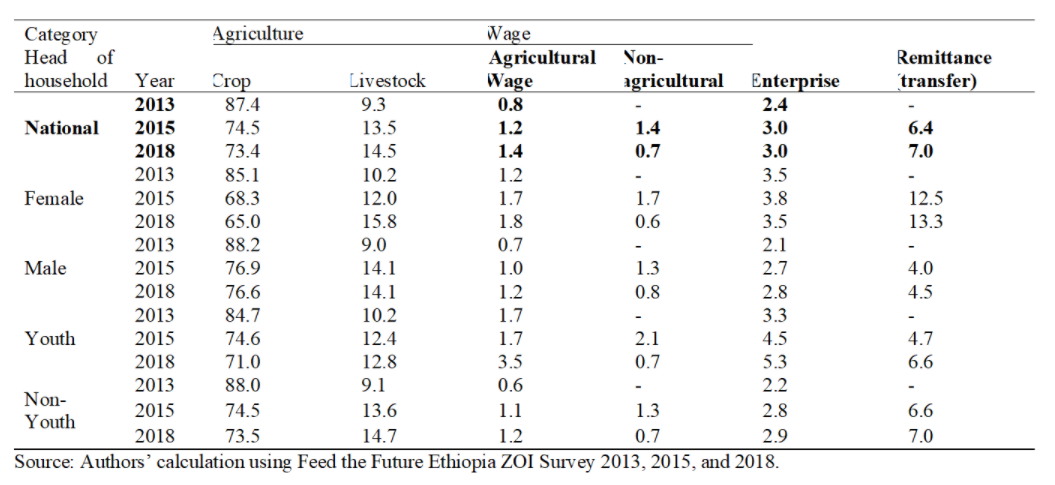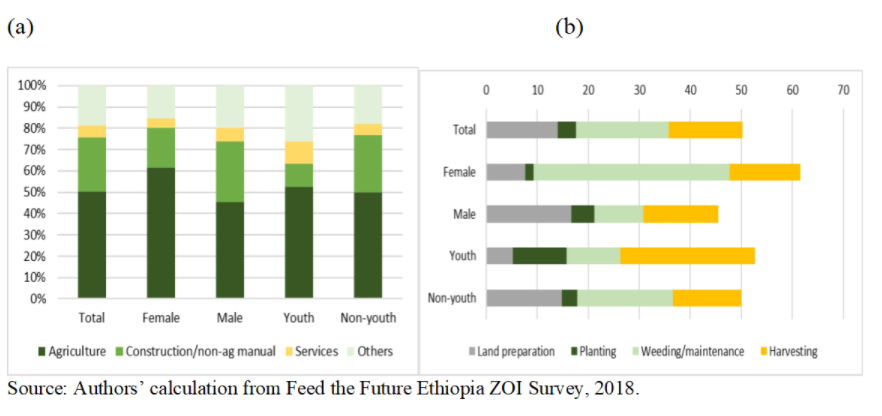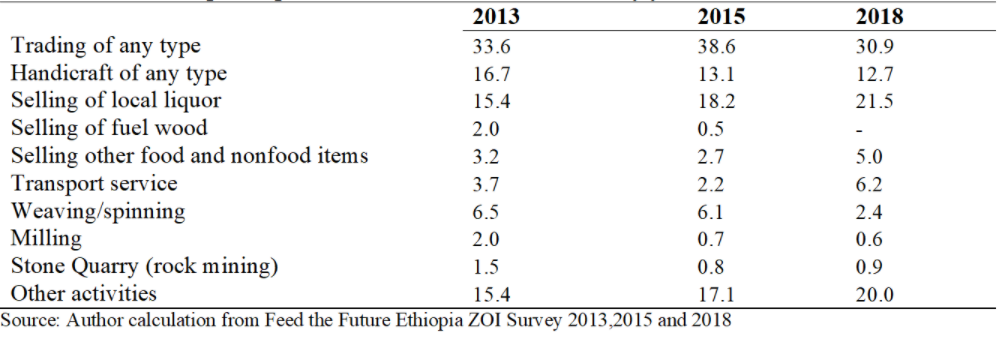
Prospects for rural jobs in Ethiopia
Ethiopia’s burgeoning rural population are in need of off-farm employment which the heavily agriculture-reliant economy will struggle to provide. As available land becomes less accessible, rural youth need alternative sources of income to support themselves. To answer this, we surveyed households in Ethiopia on the types of income sources currently available and what factors affect households’ selection of income-generating activities.
Despite rapid economic growth over the last few decades, Ethiopia’s economy still relies heavily on agriculture. Over 90% of rural residents are engaged in crop production – too much to be sustainable, and at its current level, poses numerous threats to future growth. First, cropland is limited; landholding size is declining across farmers of all age groups, particularly youth farmers. Second, the rural population is quickly growing; growth in the working age population (15-64 year olds) is faster relative to growth in available cultivated land. This trend will likely continue, leading to 24% more residents and 44% more working age people in rural areas by 2037, relative to 2017 figures. Third, Ethiopia’s youth which account for roughly 70% of the overall population and predominantly reside in rural areas are becoming increasingly educated and looking to opportunities outside of agriculture.
Given the contraction of per capita arable land and the increasing number of better educated youth in rural areas, policies that facilitate the emergence and expansion of non-agricultural rural jobs are indispensable to absorb the rapidly growing working-age population. Within agriculture, a related question is the contribution of agricultural wage income along with income from own production in households’ total income. Thus, our research investigated the types of rural off-farm income and income diversification in rural areas. We assessed household and local factors associated with participating in off-farm activities and the contribution of off-farm activities to nationwide and rural employment.
Measuring income-generating activities in rural Ethiopia
This study primarily relies on data collected in the baseline (2013), midline (2015), and endline (2018) household surveys from Phase I of Feed the Future (FtF-I) programme, covering 84 woredas (districts) in five regions of the country: Tigray, Amhara, Oromiya, Somali, and the Southern Nations, Nationalities, and Peoples’ (SNNP) regions. To analyse factors associated with participation in different income-generating activities, particularly with off-farm income, we use the Double Hurdle (DH) model to identify determinants of the decision to engage in income-generating off-farm activity and, given the first choice, the proportion of income from off-farm sources.
Income sources and their alternatives
Wage income increased rapidly during the study period, both agricultural and non-agricultural, particularly between 2013-2015. Agricultural wage income includes payments for land preparation, planting, weeding, and harvesting, whereas non-agricultural wage income consists of any other salary work such as teachers, construction workers, soldiers, and more. Enterprise income also increased its share over the study period. Enterprise and agricultural wage income are more important for households with female and youth heads, albeit still a small share of total. While the rural off-farm sector remains one potential alternative in supporting jobs in the rural areas, and in fact showed modest gains during the study period, household participation in off-farm activities remains very low.
Table 1. Contribution of activities to rural household income

Income sources vary by gender of household head
The data do not allow for complete disaggregation by gender since income sources by intra-household members have not been collected (and most women live in male-headed households). Nonetheless, one can see differences depending on gender of household head (Figure 1). For example, 60% of female-headed households are engaged in the participation of agricultural wage income. From farm activities, the engagement of female heads in weeding took the lion’s share (around 39%). Nonetheless, around 45% of male-headed households also participated in agricultural wage income. This indicates that agricultural wage income is of greater importance for women who may have lower access to capital. Women who face resource constraints, especially agricultural land, tend to take up off-farm wage activities as their main income source. In contrast, male-headed households are engaged more on non-agricultural wage activities (such as construction workers) compared to female-headed households.
Figure 1. Extent of wage labour participation by gender of head of households

For business enterprise income, trading remains an important source of non-farm business, including trading of grain, livestock production, and retail of non-agricultural goods. Selling of local liquor is the second-most and increasingly important activity in which farmers are participating. This along with handicraft activities remain important, especially for female-headed households. Transport services have also increased in importance over time, suggesting there could be greater room for private transport services.
Table 2: Household participation rate of non-farm activities by year

Factors influencing household selection of income-generating activities
Relying on estimates from the Double Hurdle model, a key factor that influences the decision is low access to land (and similarly less livestock). Second, families run by young household heads are more likely to engage in off-farm activities, regardless of access to land. Also, non-married household heads and those with larger household size are more likely to be involved in off-farm income-generating activities. Third, households that are in areas with high population density are more likely to be involved in off-farm activities. However, given participation, the extent of involvement is smaller compared to households located in less dense areas. Similarly, households located in areas that receive (or are dependent on) the Productive Safety Net Programme (PSNP) or are in areas where forest coverage increased over the last five years appear to be more likely to be involved in off-farm income-generating activities. For PSNP, it is not clear whether this is directly linked to the public works component resulting in non-farm wage income or indirectly linked to the cash transfer component that stimulates local demand for enterprise services. Households located in areas with better annual rainfall seem less likely to participate in off-farm activities, but once they participate, a greater proportion of their income comes from that. Fourth, access to infrastructure and services are also found to influence the participation and extent of engagement in off-farm activities. Households with better access to electricity, credit facility, and mobile phones are more likely to take part in off-farm income-generating activities. Farmers with access to road transport, as proxied by travel time to the nearest town, are also found to be more likely to engage in off-farm activities.
Implications for increasing off-farm employment
Job opportunities in rural areas (farming or off-farm) have the potential to retain more youth in rural areas. However, analysis of the FtF-I panel survey confirms that household participation in income generating off-farm activities in Ethiopia remains very low, and given participation, the income from it generates a low share, about 5% of total income. Further analysis is needed to inform policy aimed at increasing rural jobs to levels seen in other countries. This research suggests a couple of areas amenable to policy support. Access to infrastructure is an important determinant. This includes continued programmes of transport infrastructure to bring households closer to urban and peri-urban markets. It also includes expansion of mobile phone coverage which opens channels for rural households to explore off-farm and agricultural wage opportunities. Indications are that any facilitation of off-farm income opportunities will disproportionately favour female-headed households.

